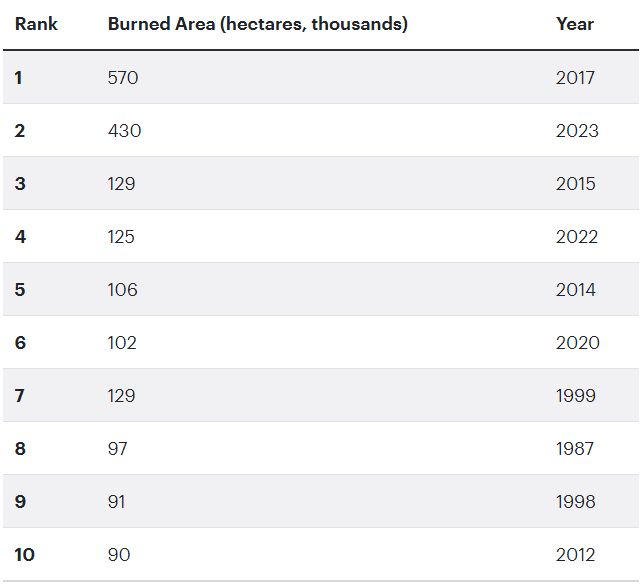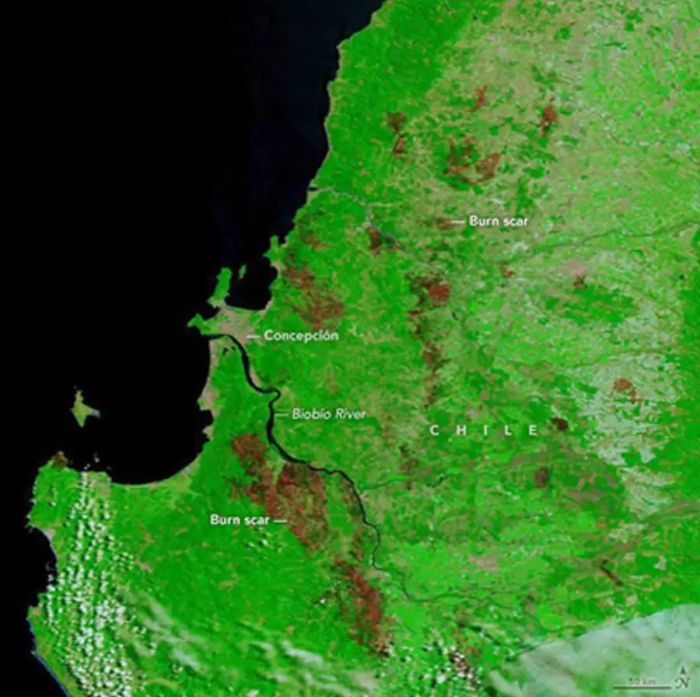Wildfires ravaged Chile in February, affecting the Maule, Biobio, Ñuble, and Araucania regions. With similar fires in 2017, there's growing concern about the deadly combination of climate & land-use change.
Central Chile has been experiencing a megadrought since 2010, making it one of the longest periods of dry weather in the last 1,000 years1. Water availability and vegetation have suffered, resulting in a number of destructive forest fires. Seven of the top ten wildfire years on record have now occurred since 2010, highlighting the severity of the situation (Table 1).
The most recent event began on January 30, during the summer season in the Southern Hemisphere. Record temperatures of over 40°C, combined with strong winds, created ideal fire-spreading conditions. This led to more than 400 individual fires burning across south-central Chile by early February. Approximately 430,000 hectares were burned (Figure 1), resulting in 26 fatalities and over 4,000 damaged or destroyed buildings, according to Chile's disaster response agency, SENAPRED.
Table showing seven of the top ten wildfire years on record have now occurred since 2010

Table 1 : Seven of the top ten wildfire years on
record have now occurred since 2010, highlighting the severity of
the situation.
Source : Chile's National Forest Corporation
(CONAF).
This makes 2023 the second worst fire year on record, after 2017, when 570,000 hectares of central and southern Chile were affected. Like this year, the underlying drought conditions in 2017 combined with high temperatures and winds, resulting in disastrous consequences. However, this is only half of the story; in 2020, Chile's Centre for Climate and Resilience Sciences (CR)2 issued a report recommending increased regulation of the forestry industry in order for the country to become more resilient to the effects of climate change2.

Figure 1. Burned area from the February 2023
wildfires in south-central Chile.
Source: NASA's Earth Observatoryon
Previous governments encouraged this expansion by allowing...privatisation of public land and providing subsidies and tax breaks for plantations.
Forestry is big business in Chile, accounting for 3% of the country's GDP, and timber is the second-largest export commodity after minerals. Expansive plantations of fast-growing species (primarily pine and eucalyptus) have increased from 300,000 hectares in the 1970s to over 3 million hectares today. Previous governments encouraged this expansion by allowing the privatisation of large areas of public land and providing subsidies and tax breaks for plantations.
The problem is that non-native pine and eucalyptus species contain oils and resins in their leaves that can easily ignite when dry. Research has also found that because plantations are often compositionally homogenous with few fire breaks, it promotes greater fire spread compared to native deciduous forests3. This, combined with the recent drought, has created a perfect storm that has proved difficult to control.
According to scientists, the megadrought is most likely the result of both natural variability and human-induced climate change1.
According to scientists, the megadrought is most likely the result of both natural variability and human-induced climate change1.
However, climate change is expected to play an increased role in wildfire risk over the coming decades. Projections for the 21st-century indicate a rise in temperatures and a reduction in precipitation throughout Chile, which modelling studies suggest will lead to an increased occurrence of large fires4.
Projections for the 21st-century indicate a rise in temperatures and a reduction in precipitation ... which ... suggest will lead to an increased occurrence of large fires.4
Central-South Chile is particularly vulnerable because it contains nearly 90% of the country's plantations, and 3 million people live within the wildland-urban interface5. (CR)2 says that if the government is to reduce the risk faced by its people, decision-makers need to move away from reactive measures focused on fire suppression, towards actions that target the source of the problem. This includes better landscape management, establishing safety perimeters around urban areas, and new laws to prevent unsafe practices such as the expansion of homes into forested regions2.
Footnotes
1. Garreaud, R. D. et al. The Central Chile Mega Drought (2010–2018): A climate dynamics perspective. International Journal of Climatology 40, 421–439 (2020).
2. Center for Climate and Resilience Research - CR2. Forest fires in Chile: Causes, impacts and resilience. Forest fires in Chile: Causes, impacts and resilience (2020).
3. McWethy, D. B. et al. Landscape drivers of recent fire activity (2001-2017) in south-central Chile. PLOS ONE 13, e0201195 (2018).
4. Ciocca, I. et al. Increased wildfire hazard along South-Central Chile under the RCP8.5 scenario as revealed by high-resolution modeling. Environ. Res. Lett. 18, 034023 (2023).
5. Sarricolea, P. et al. Recent wildfires in Central Chile: Detecting links between burned areas and population exposure in the wildland urban interface. Science of The Total Environment 706, 135894 (2020).
Download
Originally published 20 July 2023
The content of this article is intended to provide a general guide to the subject matter. Specialist advice should be sought about your specific circumstances.


